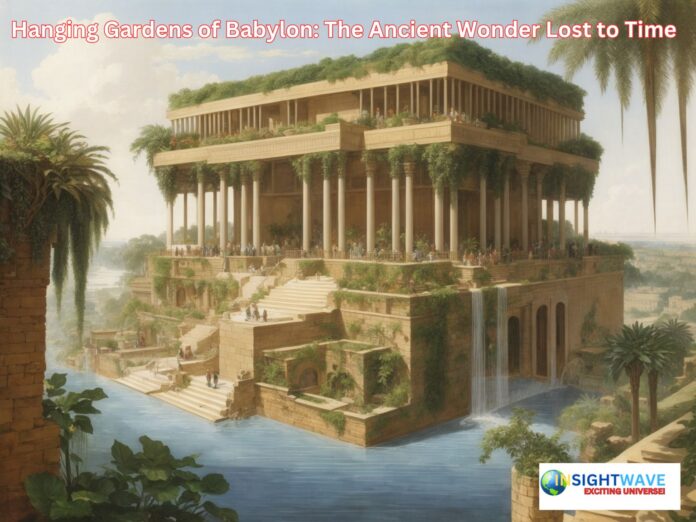The annals of history are replete with tales of remarkable feats and extraordinary structures. Among these, the Hanging Gardens of Babylon stand as a testament to the opulence, architectural ingenuity, and botanical marvels of the ancient world. Although the gardens have long since disappeared, their legend endures, inviting us to explore the mysteries, historical context, and enduring fascination surrounding the Hanging Gardens.
Unearthing the Mystery
The Hanging Gardens of Babylon, one of the Seven Wonders of the Ancient World, have captivated the imagination of scholars, historians, and dreamers for centuries. Mentioned in various ancient texts, their existence has fueled a relentless quest to uncover the truth behind this extraordinary creation.
The Accounts
The earliest and most detailed account of the Hanging Gardens can be traced back to the writings of the ancient Greek historian Strabo, who lived around 63 BCE to 24 CE. According to Strabo, the gardens were constructed in the 6th century BCE by King Nebuchadnezzar II, the famed ruler of the Neo-Babylonian Empire. Nebuchadnezzar, it is said, built the gardens as a testament to his love for his wife, Amytis of Media, who longed for the lush greenery of her homeland.
Challenges in Verification
Despite the vivid descriptions provided by Strabo and other ancient sources, the exact location, design, and even the existence of the Hanging Gardens have remained subjects of debate and speculation. The lack of physical evidence, such as inscriptions or architectural remains, has posed significant challenges to verifying their existence.
The Grandeur of the Gardens
The descriptions of the Hanging Gardens in ancient texts paint a vivid picture of their magnificence.
Ascending Terraces
The most distinctive feature of the gardens was their tiered structure, resembling a series of ascending terraces or balconies. Each terrace was said to be supported by massive stone columns and lined with a layer of waterproof bitumen to prevent water seepage. The gardens were believed to reach a height of over 75 feet (23 meters) and cover an area of approximately 400 square feet.
Cascading Waterfalls
To achieve the appearance of hanging gardens, a complex irrigation system was supposedly employed. Water was drawn from the Euphrates River and transported to the upper terraces via a network of channels and aqueducts. As the water flowed down the terraces, it cascaded over the edges, creating the illusion of lush, hanging foliage. It’s this ingenious watering system that has led many to consider the Hanging Gardens a masterpiece of ancient engineering.
Lush Flora and Exotic Plants
The gardens were said to be adorned with a rich variety of flora, including exotic trees, shrubs, and flowering plants from distant lands. The scent of blossoms and the vibrant colors of the vegetation were described as a mesmerizing spectacle. Some accounts even mention the presence of fruit-bearing trees, providing a source of sustenance for the royal household.
Architectural Enigma
The Hanging Gardens of Babylon, if they indeed existed as described, would have represented an architectural marvel of their time.
The Engineering Challenge
Building a series of terraced gardens with a complex irrigation system in the arid Mesopotamian region posed significant engineering challenges. The choice of Babylon, with its scorching summers and limited water resources, only adds to the mystery. The ability to transport water from the Euphrates River and maintain a lush oasis in such a climate would have required innovative solutions and exceptional skill.
Design and Aesthetics
The aesthetic design of the Hanging Gardens, with its lush greenery, cascading waterfalls, and orderly terraces, speaks to the meticulous planning and artistic sensibilities of the builders. The choice of exotic plants and the arrangement of the gardens would have been a deliberate endeavor to create an oasis of tranquility and beauty.
Possible Locations and Disappearances
One of the greatest mysteries surrounding the Hanging Gardens is their location.
Historical References
Most historical references place the Hanging Gardens in Babylon, near present-day Hillah, Babil, Iraq. However, as previously mentioned, the absence of physical evidence at the traditional site has cast doubt on their existence there.
Alternative Theories
Some theories suggest that the gardens may have been located in Nineveh, the capital of the Assyrian Empire, rather than Babylon. This theory posits that the description of the gardens in ancient texts was a result of historical inaccuracies or transcriptions errors. Another theory proposes that the gardens were not truly “hanging” but rather terraced gardens with a lush, terraced appearance.
Cultural and Historical Significance
The Hanging Gardens of Babylon, whether real or the stuff of legend, hold significant cultural and historical importance.
Cultural Inspiration
The gardens have inspired countless works of art, literature, and architecture throughout history. Their legendary beauty and the romantic story of their creation continue to captivate the imagination of people worldwide.
Symbol of Power and Opulence
If the Hanging Gardens did exist as described, they would have been a symbol of the immense wealth, power, and sophistication of the Neo-Babylonian Empire. Their creation would have required vast resources and the ability to mobilize a skilled workforce.
Enduring Wonder
The fascination with the Hanging Gardens endures, not only for their potential existence but also for the mysteries they represent. Their elusive nature and the debate surrounding their location and design remind us of the gaps in our understanding of ancient civilizations and the enduring allure of enigmas from the past.
Conclusion
The Hanging Gardens of Babylon, whether a product of historical reality or myth, remain a symbol of human creativity, ambition, and devotion. Their legend invites us to explore the boundaries of historical truth and the enduring fascination with the mysteries of the ancient world.
While the gardens themselves may have vanished with time, their legacy lives on in the stories they have inspired, the questions they have raised, and the wonder they continue to evoke. The Hanging Gardens, whether nestled among the terraces of Babylon or suspended in the realm of legend, serve as a reminder of the enduring allure of ancient wonders that continue to captivate our collective imagination.


